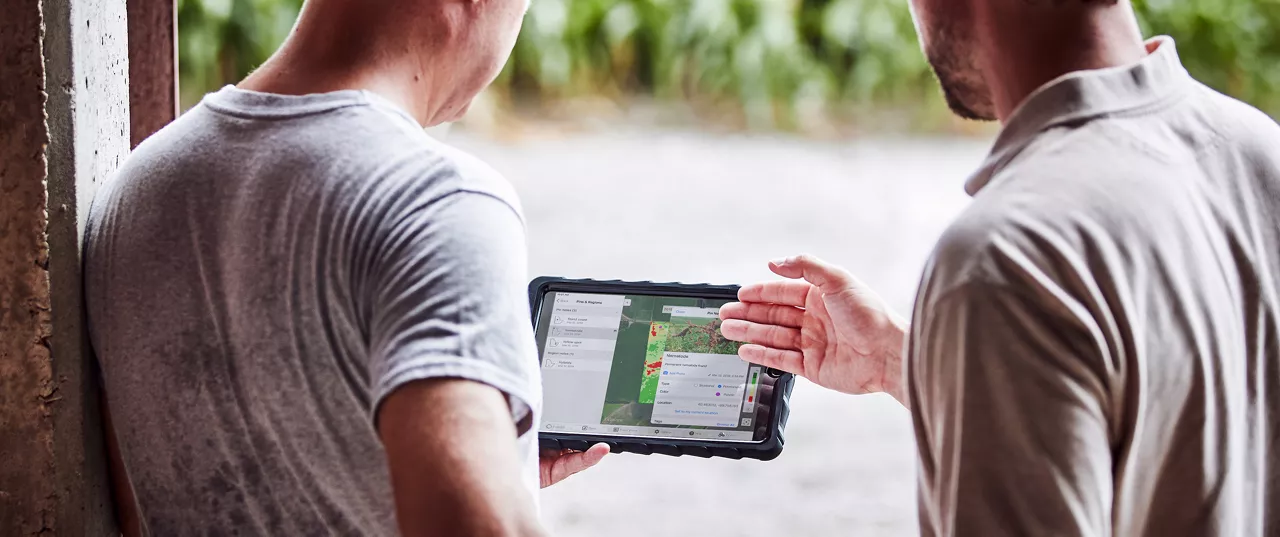
Fast, Stable, Secure. Meet Drive 2.0
The FieldView Drive 2.0 can send seed scripts without a thumb drive, has built-in GPS, offers faster data syncing and compatibility with a wider range of equipment.
How to balance corn and soy acres is just one of the many impactful decisions you’ll need to make at planting, and with this year’s challenges, it’s important to take control of everything you can.

Following a rough year of tariff negotiations that saw soybean prices greatly decline and an extended harvest in the Midwest that kept many farmers in the fields until after Thanksgiving due to wet conditions, farmers are facing more uncontrollable variables than ever as they head into planting. One farmer recently said that this year is “one for the books.”
Given the uncertain soy market, the USDA is forecasting that farmers will plant more corn in 2019 (92 million acres, a 3.2% increase from 2018), while decreasing soybean production. How to balance corn and soy acres is just one of the many impactful decisions you’ll need to make at planting, and with this year’s challenges, it’s important to take control of everything you can. The farmers I work with in northern Illinois tell me that they are looking for ways to better understand the variables in their fields to inform their decisions.
Many farmers are finding that digital farming can help them make the best possible agronomic decisions, do more with less and enhance their yield potential.
Here are just a few of the ways digital farming — and for me and the farmers I work with that’s Climate FieldView™ — can make a difference in your operation at planting time and throughout the year:
This time of year, it’s critical to collect your planting data in a uniform way so you can use it to analyze your harvest data in the fall. Spending just a few minutes entering hybrids that you intend to plant this spring will provide some great benefits. For example, a pre-populated list will appear each time you are selecting the hybrid that’s in the planter, which will save you time when you’re ready to start planting. You can even take this one step further and assign hybrids to specific fields, which brings the desired hybrids to the top of the list when you enter a new area. The biggest benefit? You will have consistent hybrid names, making your analysis more accurate as you review your planting data by field, hybrid, seed treatment, and planter. Come harvest time, you’ll be able to analyze crop performance by field, hybrid, seed treatment, and soil type.
The FieldView seed bag tag scanning feature makes it fast and easy to scan the name of a hybrid or variety with an iPad® device. This data will be uploaded directly into the FieldView Cab app hybrid/variety list that is available for quick selection during planting.
As you prepare to head into the fields for planting, many of you will use variable rate seeding to manage seed populations in specific areas of your fields. An easy, fast and effective way to accomplish this is with the FieldView™ advanced seed prescription tool that, with the expertise of your dealer, can help you write prescriptions in minutes instead of days or even weeks. Aside from making variable rate seeding easier and more efficient, this resource will also put your historical data to work for you by using it to create management zones that are highly repeatable each year. This, combined with years of hybrid trial data, will generate a science backed-prescription that you can use to plant with confidence.
How will you monitor crop health as we progress into the late spring and summer months? FieldView field health tools can make things easier by tracking your fields with satellite imagery to help prioritize field scouting. These tools not only help you catch issues early, but they are a great way to collaborate with your dealer or agronomist. By sharing access to your fields with those that might be helping you scout, you each have the ability to drop pins in specific areas of the field that may need addressed. See a region you want to be sure to track at harvest time? A FieldView field region report tool can be used similarly to a scouting pin – on any map layer, simply draw a circle or square around the area that you want to monitor and then tap the Save Region button. After harvest, you can review this data to see how that region performed.
Once harvest arrives, the FieldView yield analysis tool can help you use your harvest and planting data to draw comparisons across your operation. This information can also help you quickly determine how your decisions and agronomic practices — including split planting and field trials — impacted yield, essentially turning every one of your acres into a test plot.

Use side-by-side maps to compare critical data layers in your field, including yield, soil maps, application rate, seed population rate and more.
As spring draws near, I wish you a safe planting season and encourage you to explore the full potential of digital agriculture to gain valuable insights that will help you both now and in the future. If you have any questions, contact your Climate dealer, the Climate Support Team at (888) 924-7475 or support@climate.com.